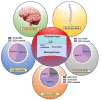Biosubstitutes for dural closure: Unveiling research, application, and future prospects of dura mater alternatives
- PMID: 38343772
- PMCID: PMC10858672
- DOI: 10.1177/20417314241228118
Biosubstitutes for dural closure: Unveiling research, application, and future prospects of dura mater alternatives
Abstract
The dura mater, as the crucial outermost protective layer of the meninges, plays a vital role in safeguarding the underlying brain tissue. Neurosurgeons face significant challenges in dealing with trauma or large defects in the dura mater, as they must address the potential complications, such as wound infections, pseudomeningocele formation, cerebrospinal fluid leakage, and cerebral herniation. Therefore, the development of dural substitutes for repairing or reconstructing the damaged dura mater holds clinical significance. In this review we highlight the progress in the development of dural substitutes, encompassing autologous, allogeneic, and xenogeneic replacements, as well as the polymeric-based dural substitutes fabricated through various scaffolding techniques. In particular, we explore the development of composite materials that exhibit improved physical and biological properties for advanced dural substitutes. Furthermore, we address the challenges and prospects associated with developing clinically relevant alternatives to the dura mater.
Keywords: Dura mater; brain trauma and injury; composites; dural substitutes; polymeric scaffolds; tissue engineering.
© The Author(s) 2024.
Conflict of interest statement
The author(s) declared no potential conflicts of interest with respect to the research, authorship, and/or publication of this article.
Figures












Similar articles
-
Biomimetic and Nonbiomimetic Approaches in Dura Substitutes: The Influence of Mechanical Properties.Tissue Eng Part B Rev. 2025 Apr;31(2):174-189. doi: 10.1089/ten.TEB.2024.0079. Epub 2024 Jul 8. Tissue Eng Part B Rev. 2025. PMID: 38874958 Review.
-
Super-hydrophilic and super-lubricating Zwitterionic hydrogel coatings coupled with polyurethane to reduce postoperative dura mater adhesions and infections.Acta Biomater. 2025 Jan 15;192:206-217. doi: 10.1016/j.actbio.2024.12.038. Epub 2024 Dec 13. Acta Biomater. 2025. PMID: 39675498
-
Current developments in dural repair: a focused review on new methods and materials.Front Biosci (Landmark Ed). 2013 Jun 1;18(4):1335-43. doi: 10.2741/4182. Front Biosci (Landmark Ed). 2013. PMID: 23747886 Review.
-
Biocompatibility evaluation of dura mater substitutes in an animal model.Neurol Res. 2001 Dec;23(8):813-20. doi: 10.1179/016164101101199405. Neurol Res. 2001. PMID: 11760872
-
Applications of materials for dural reconstruction in pre-clinical and clinical studies: Advantages and drawbacks, efficacy, and selections.Mater Sci Eng C Mater Biol Appl. 2020 Dec;117:111326. doi: 10.1016/j.msec.2020.111326. Epub 2020 Aug 5. Mater Sci Eng C Mater Biol Appl. 2020. PMID: 32919680 Review.
Cited by
-
Heterogeneity in cranial dura mater at the microscale: An In-situ and ex-vivo structural and mechanical investigation of sulcus and gyrus Dura.Acta Biomater. 2025 Apr;196:222-232. doi: 10.1016/j.actbio.2025.02.053. Epub 2025 Feb 25. Acta Biomater. 2025. PMID: 40015354 Free PMC article.
-
The concepts of Intra Spinal Pressure (ISP), Intra Thecal Pressure (ITP), and Spinal Cord Perfusion Pressure (SCPP) in acute, severe traumatic spinal cord injury: Narrative review.Brain Spine. 2024 Oct 16;4:103919. doi: 10.1016/j.bas.2024.103919. eCollection 2024. Brain Spine. 2024. PMID: 39654909 Free PMC article. Review.
-
High-Strength and Rapidly Degradable Nanocomposite Yarns from Recycled Waste Poly(glycolic acid) (PGA).Polymers (Basel). 2025 Jan 2;17(1):100. doi: 10.3390/polym17010100. Polymers (Basel). 2025. PMID: 39795503 Free PMC article.
-
Iatrogenic cerebral amyloid angiopathy: Two cases linked to childhood cadaveric dural transplantation for different intracranial pathologies, diagnosed using the simplified Edinburgh computed tomography criteria.Surg Neurol Int. 2025 May 2;16:165. doi: 10.25259/SNI_245_2025. eCollection 2025. Surg Neurol Int. 2025. PMID: 40469355 Free PMC article.
-
Neuroprotective Riluzole-Releasing Electrospun Implants for Spinal Cord Injury.Mol Pharm. 2025 Jun 2;22(6):2905-2916. doi: 10.1021/acs.molpharmaceut.4c01270. Epub 2025 May 16. Mol Pharm. 2025. PMID: 40378306 Free PMC article.
References
-
- Yu X, Yue P, Peng X, et al.. A dural substitute based on oxidized quaternized guar gum/porcine peritoneal acellular matrix with improved stability, antibacterial and anti-adhesive properties. Chin Chem Lett 2023; 34: 107591.
-
- Song Y, Li S, Song B, et al.. The pathological changes in the spinal cord after dural tear with and without autologous fascia repair. Eu Spine J 2014; 23: 1531–1540. - PubMed
-
- Wang W, Ao Q. Research and application progress on dural substitutes. J Neurorestoratol 2019; 7: 161–170.
Publication types
LinkOut - more resources
Full Text Sources

